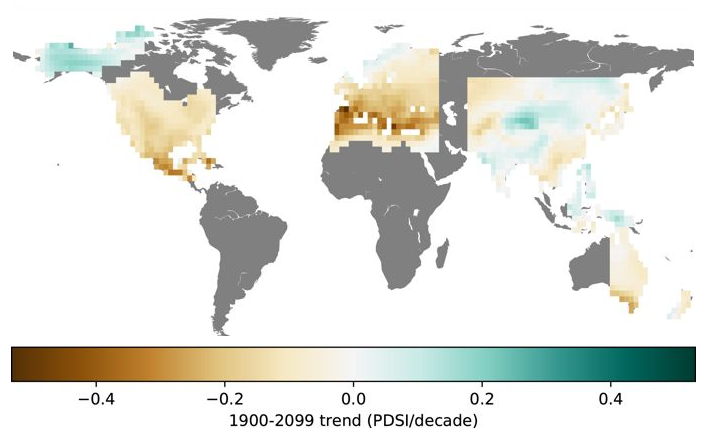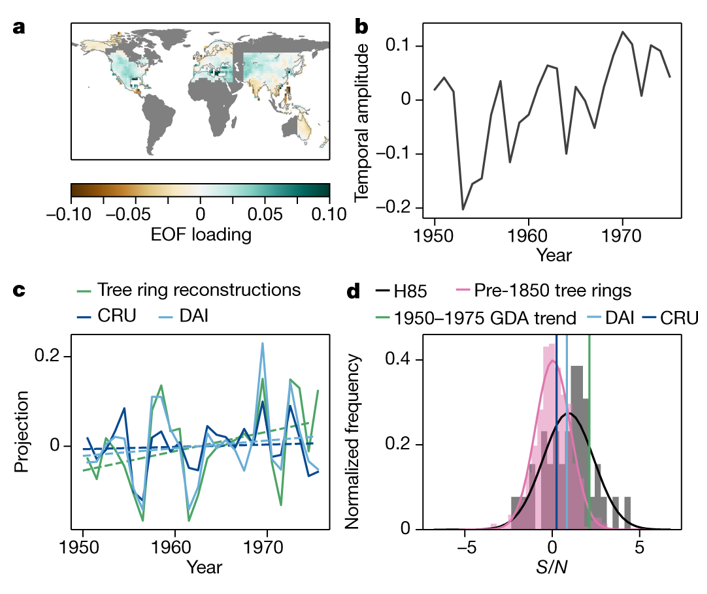Reducing air pollution may worsen droughts globally – “It’s mind boggling. There is a really clear signal of the effects of human greenhouse gases on the hydroclimate.”

By James Temple
1 May 2019
(Technology Review) – Climate change is clearly making some regions wetter and others drier. But it’s been difficult for scientists to detect a clear, consistent human role in increasing the frequency and severity of global droughts given natural climate variability, regional differences, and limited data.
A new report in Nature adds evidence to the suspicion that air pollution could be complicating the science, masking the role of greenhouse gases on droughts.
Research has already found that air pollution has likely moderated the level of global warming (see “We’re about to kill a massive, accidental experiment in reducing global warming”). The newest findings suggest this could have played a role in reducing droughts as well, likely by decreasing the level of soil-moisture drying that would have otherwise occurred.
If so, as the world continues to clean up air pollution, the impact of climate change on droughts will get even more severe.
In the new study, researchers at NASA, Columbia University, and Lawrence Livermore National Laboratory analyzed tree ring records to document shifting soil-moisture conditions over time. They found three distinct trends: a clearly detectable human fingerprint on drought levels in the first half of the last century, a diverging trend between 1950 and 1975, and then a return to a positive, though not particularly strong, signal in the years since.
The researchers note that this middle period coincides with an increase in atmospheric aerosols, the tiny particles spewed from planes, cars, coal plants, farms, and even natural events like forest fires and volcanoes. Depending on the particles, they can alter cloud formation, change rainfall patterns, trap heat, or reflect sunlight away from the planet.
Notably, global air pollution levels began to come down sharply in the mid- to late 1970s, with the passage of the US Clear Air Act in 1970 and similar regulations in Europe. That at least correlates with the climate signal pattern noted in the study. [more]
Cleaning up the air we breathe might actually be making droughts worse

Scientists See Fingerprint of Warming Climate on Droughts Going Back to 1900
By Kevin Krajick
1 May 2019
(Columbia University) – In an unusual new study, scientists say they have detected the fingerprint of human-driven global warming on patterns of drought and moisture across the world as far back as 1900. Rising temperatures are well documented back at least that far, but this is the first time researchers have identified resulting long-term global effects on the water supplies that feed crops and cities. Among the observations, the researchers documented drying of soils across much of populous North America, Central America, Eurasia and the Mediterranean. Other areas, including the Indian subcontinent, have become wetter. They say the trends will continue, with severe consequences for humans. The study appears this week in the leading journal Nature.
In general, scientists agree that as global warming progresses, many now dry regions will become drier, and wet ones will become wetter. Some recent studies suggest that human-induced warming has intensified droughts in particular regions, including a now near 20-year ongoing drought in the southwestern United States. However, the last report by the Intergovernmental Panel on Climate Change says confidence in attributing specific ongoing events directly to humans is still chancy.
The new study combines computer models with long-term observations to suggest that systemic changes in what scientists call the hydroclimate are already underway across the world, and have been for some time. The researchers looked not simply at precipitation, but rather soil moisture, a more subtle measure that balances precipitation against evaporation, and is the quality most directly relevant to farming and forestry. They used tree rings going back 600 to 900 years to estimate soil moisture trends before human-produced greenhouse gases started rising, then compared this data with 20th-century tree rings and modern instrumental observations, to see if they could pick out drought patterns matching those predicted by computer models, amid the noise of natural yearly or decadal regional weather variations.
“We asked, does the real world look like what the models tell us to expect?” said study coauthor Benjamin Cook of the NASA Goddard Institute for Space Studies and Columbia University’s Lamont-Doherty Earth Observatory. “The answer is yes. The big thing we learned is that climate change started affecting global patterns of drought in the early 20th century. We expect this pattern to keep emerging as climate change continues.”
Lead author Kate Marvel, a climate modeler at Goddard and Columbia University, said, “It’s mind boggling. There is a really clear signal of the effects of human greenhouse gases on the hydroclimate.”
Soil moisture is a complex issue, because precipitation and evaporation can work with each other, or against each other. Warmer air can carry more moisture, and thus more rain or snow. But warmer air can also evaporate more moisture from soil and carry it away, outweighing precipitation. That is probably the factor now at work in the drying western United States, and possibly other locations that have seen recent big droughts. “Precipitation is just the supply side,” said study coauthor Jason Smerdon, a Lamont-Doherty paleoclimatologist. “Temperature is on the demand side, the part that dries things out.” Which part predominates depends on complex factors including wind patterns, seasons, clouds, topography and proximity to the moisture-giving oceans.
The scientists identified three distinct periods in their study. The first was 1900 to 1949, when they say the global-warming fingerprint was the most obvious. During this time, as predicted by models, drying was seen in Australia, much of central America and North America, Europe, the Mediterranean, western Russia and southeast Asia. At the same time, it got wetter in western China, much of central Asia, the Indian subcontinent, Indonesia and central Canada.
From 1950 to 1975, the pattern scattered into seemingly random events. The scientists believe this might be related to enormous amounts of industrial aerosols then being poured into the air without modern pollution controls. These can affect regional cloud formation, rainfall and temperature, by, among other things, blocking solar radiation and providing nuclei for moisture droplets. The researchers believe that the complex effects of aerosols probably threw a monkey wrench into the weather in many places, masking the effects of greenhouse gases, even though those gases continued to rise.
Then, starting in the 1970s, many industrial countries including the United States started instituting progressively stricter clean-air laws. Even though industrial activities continued to grow, aerosols quickly leveled off or slightly declined in many places. But at the same time, greenhouse-gas emissions continued spiraling up, along with temperatures. As a result, the researchers say, the global-warming signature on hydroclimate began re-emerging around 1981. The signal is not yet as obvious as it was in the early 20th century, but it continues to rise, especially since around 2000.
“If we don’t see it coming in stronger in, say, the next 10 years, we might have to wonder whether we are right,” said Marvel. “But all the models are projecting that you should see unprecedented drying soon, in a lot of places.”
Many of the areas expected to dry out are centers of agricultural production, and could become permanently arid. “The human consequences of this, particularly drying over large parts of North America and Eurasia, will likely be severe,” says the study.
Precipitation over much of central America, Mexico the central and western United States and Europe is projected to stay about the same, or even increase. But, according to both the new study and a separate 2018 paper, rising temperatures and resulting evaporation of moisture from soils in those regions will probably predominate. The Mediterranean region is expected to be hit with a double whammy of both less rainfall and more heat-driven evaporation. Adding to the drought dynamics of all the affected areas: populations are expected to continue increasing, adding to water demand. According to an earlier Lamont-Doherty study, a 2006-2010 drought leading up to the disastrous Syrian civil war was probably made more likely by warming climate, and the drought may have helped create the social and economic conditions that sparked the initial rebellion.
Some areas are expected to get wetter, but this may not necessarily be good. India and some surrounding nations are expected to get more rain, because they sit squarely in the path of monsoon winds that pick up moisture from the Pacific and Indian oceans, and those oceans are getting warmer. But the rain may come perhaps more often in overwhelming storms, and not necessarily at times when it is needed.
The new study was made possible in part by recently published atlases of tree-ring chronologies from thousands of sites around the world, going back as far as 2,000 years. These gave the researchers a baseline of how weather varied before humans started heavily affecting it. The atlases are largely the work of Lamont-Doherty scientist Edward Cook, father of study coauthor Benjamin Cook. The North American drought atlas came out in 2004, followed by a Monsoon Asia atlas in 2010, and compilations for Europe and the Mediterranean, Mexico and Australia/New Zealand in 2015. (One for South America is on the way; much of Africa still remains uncovered.)
“This important paper offers new insights into the link between increasing atmospheric greenhouse gases and regional droughts, both in the past and increasingly in the future,” said Peter Gleick, cofounder of California’s Pacific Institute, and expert on climate and water issues. “It also confirms the growing sophistication of our climate models and improves the tools available to detect and identify the fingerprint of human impacts on extreme hydrologic events.”
The study was coauthored also by Céline Bonfils and Paul Durack of Lawrence Livermore National Laboratory, and A. Park Williams of Lamont-Doherty.
Scientists See Fingerprint of Warming Climate on Droughts Going Back to 1900
ABSTRACT: Although anthropogenic climate change is expected to have caused large shifts in temperature and rainfall, the detection of human influence on global drought has been complicated by large internal variability and the brevity of observational records. Here we address these challenges using reconstructions of the Palmer drought severity index obtained with data from tree rings that span the past millennium. We show that three distinct periods are identifiable in climate models, observations and reconstructions during the twentieth century. In recent decades (1981 to present), the signal of greenhouse gas forcing is present but not yet detectable at high confidence. Observations and reconstructions differ significantly from an expected pattern of greenhouse gas forcing around mid-century (1950–1975), coinciding with a global increase in aerosol forcing. In the first half of the century (1900–1949), however, a signal of greenhouse-gas-forced change is robustly detectable. Multiple observational datasets and reconstructions using data from tree rings confirm that human activities were probably affecting the worldwide risk of droughts as early as the beginning of the twentieth century.
Twentieth-century hydroclimate changes consistent with human influence